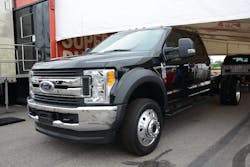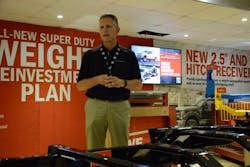DENVER, CO. Tim Pope puts his trucks to work, and he works them hard. Whether it’s trimming trees, responding to natural disasters, clearing utility land, or building roads, Pope’s trucks work around the clock and are constantly on the go.
Pope is the CEO of Rochester, NY-based companies Terry Tree Service and Ironwood Heavy Highway. He manages more than 200 employees and buys an average of 10-15 new trucks a year depending on his companies’ workloads. Right now, Pope has approximately 100 Ford Super Duty F-350s through F-750s that tow tools, excavators, and other pieces of large equipment to job sites. He’s currently waiting on the newest addition to his fleet – an F-350 King Ranch, which is part of Ford’s new 2017 Super Duty series.
Pope spoke with Fleet Owner during Ford’s All-New 2017 Super Duty press event here in Denver. “The Super Duty is important for us because all our jobs are on the road,” Pope explained. “And to get all the supplies out to the job – it’s invaluable.”
The new Super Duty’s military-grade, aluminum-alloy body and box helps reduce weight by up to 350 lbs. compared to previous models, the company said. Doug Scott, Ford’s truck group marketing manager, said this is the OEM’s first new Super Duty model since 1999. He added that the truck is made to withstand severe-duty vocations like mining, manufacturing and highway maintenance.
“These are the people that put the highest demand on the truck,” Scott said. “These are the people that the truck can’t be down for.”
The new series has larger fuel tanks – at 48 gallons – for increased driving range. And chassis cab upgrades include:
- Front gross axle weight rating of up to 7,500 lbs.
- Gross combine weight rating of up to 40,000 lbs. and increased towing
- New powertrain options: A second-generation 6.7L Power Stroke V8 Turbo Diesel that produces 330 horsepower and 750 lbs.-ft. of torque; A 6.2L FFV V8 Gas Engine option that offers 385 hp and 430 lbs.-ft of torque.
- Larger braking system
The new Super Duty also includes up to seven high-resolution cameras that give drivers a 360-degree view, trailer reverse guidance, straight line backup guidance, jackknife warning, adaptive steering, adaptive cruise control, blind spot information system with trailer coverage, and lane departure warning, among other features.
“What sold me is [driver] safety – all the additional cameras, adaptive cruise control and extra horsepower,” Pope told Fleet Owner. After driver safety, he mentioned durability coupled with low maintenance and operating costs also top his priority list.
“When a piece of equipment is down, my crew is down,” Pope explained, noting that he has an in-house maintenance facility with five full-time mechanics. “Dependability is important.”
Ford’s new Super Duty can also function as a mobile office for busy fleets. The center console could hold a full-sized laptop and two power outlets in the cab provide up to 400 total watts of power (300 while driving), the company said. The cab is also 6-in. longer and contains a flat load floor option, and the crew cab is 3-in. longer than previous models.
“What I like from a personal standpoint is that I could work the truck real hard during the day,” Pope noted. “I could have fun with it towing my boats, and then I could wash it and take my wife out to dinner at night.”
“It’s my office,” he added. “I do a lot of business driving down the road. And I’m one to put 50,000 miles on my personal truck every year.”
About the Author

Cristina Commendatore
Cristina Commendatore is a past FleetOwner editor-in-chief. She wrote for the publication from 2015 to 2023.

